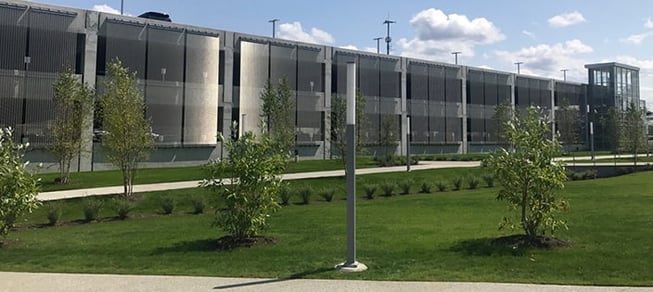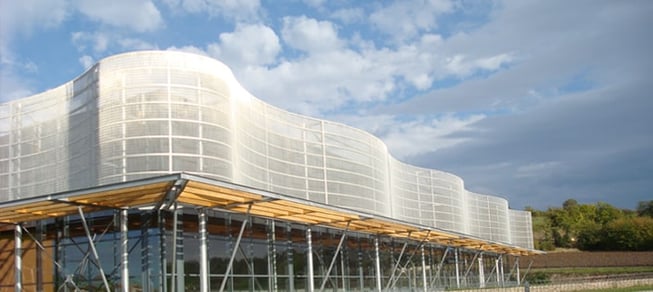How Architectural Mesh Is Used in Sports Facilities
Architectural wire mesh is a design material that offers countless benefits that unlock a design's true potential. In other words, its grants architects a sense of artistic freedom that other design materials don't.
Now, when looking at applications, architects can customize architectural mesh to accommodate most design requirements. Sports facilities, in particular, have several areas that can benefit front unique aesthetic architectural mesh has to offer.
So, how exactly can you apply architectural mesh when working on a sports facility?
For over 20 years, W.S. Tyler has been a prominent supplier of architectural wire mesh systems and strives to help you weave your vision into reality.
To that end, this article will cover:
- What architectural mesh
- How you can incorporate architectural mesh into a sports facility
- The benefits of architectural mesh
- How much architectural mesh costs
What Is Architectural Wire Mesh?
Architectural wire mesh is a decorative metal fabric that consists of a series of metallic wires that become interlaced after undergoing a heavily regulated weaving process. To ensure the weave pattern and aesthetic match your vision, parameters including the wire diameter, percentage of open area, panel width and length, as well as the amount of wires in either direction are fully customizable.

In regards to architectural wire mesh specifically, four forms are commonly used: woven wire, welded wire, spiral mesh, and cable mesh.
How Can I Apply Architectural Mesh to a Sports Facility
Architectural wire mesh is one of the most versatile design materials on the market and has the ability to enhance several areas of a sports facility. When architectural mesh is employed, areas such as parking structures, exterior facades, ceilings, and walls can be transformed into aesthetically pleasing design elements.
Parking Structure Facade
Architectural mesh is commonly used to clad the side of parking structures as it provides numerous beneficial qualities. When compared to other design materials, architectural mesh stands out as it grants the architects the artists freedom to deliver a one-of-a-kind aesthetic that offers fall protection, weather protection, and adequate natural ventilation.

For more information on parking structure design, read the following article:
3D Exterior Cladding
Three-dimensional mesh facades provide a means to create a sense of movement. As these mesh systems are designed to incorporate bends, twists, and turns, they are ideal when attempting to create a design that makes the sports facility stand out as a regional landmark.

For more information on three-dimensional exterior cladding, read the following article:
Ceiling and Wall Design
Most if not all sports facilitates encounter high levels of traffic throughout the dozens of events that take place. This, in turn, puts the technical elements, such as lighting fixtures and sprinkler systems, at risk of being damaged over time.
Architectural mesh is often employed to facilitate wall and ceiling design as its transparent qualities allow light to pass through. Additionally, as it is an open product, architectural mesh won't hinder the effectiveness of ventilation, air conditioning, or sparkler systems, making it ideal when fire regulations must be met.

For more information on ceiling and wall design, read the following articles:
- How Architectural Wire Mesh Is Used for Ceiling Design
- How Architectural Wire Mesh Is Used for Wall Design
Why Should an Architect Use Architectural Mesh?
One of the most notable benefits of using architectural wire mesh is its ability to deliver a continuous look for large-scale applications. As the length can reach 125 feet wide, architectural mesh panels can be arranged so that the full length of the structure is covered with minimal mounting hardware visible to visitors and onlookers.
Additionally, as it is considered an open product, architectural wire mesh delivers optimal levels of natural ventilation. When you consider the fact that each mesh panel can be customized to fulfill your open area requirement, wire mesh is an ideal material for applications such as parking garages.
Another critical element that should be considered is the architectural mesh's ability to be painted. This allows architects to integrate aesthetically pleasing graphics and even help eliminate costly signage packages.
How Much Does Architectural Mesh Cost?
The cost of an architectural wire mesh system depends on several factors. This includes the weave pattern, amount of material needed to weave the mesh panels, panel quantity, and the amount of fabrication required to construct the mesh panels.
To that end, the average cost of architectural wire mesh is approximately $20 to $25 per square foot.
Now, if you wish to add paint or digital print to the mesh panels, this will increase the price. Regardless of which finish you implement, you can expect to pay an additional $10 per square foot (only areas that are colorized) for flat color and $15 per square foot (only areas that are colorized) for metallic colors.
Get To Know Architectural Mesh Hands-on
Architectural mesh is a versatile design material that can benefit virtually any architectural design process. Its unique characteristics can be leveraged to create an awe-inspiring experience for various structures, such as sports facilities, inside and out.
But to ensure architectural mesh is genuinely the right solution for you and the ideal weave pattern is selected, you can and should request architectural mesh samples. This is one of the easiest ways to truly leverage the characters of architectural mesh in a way that illustrates your vision.
W.S. Tyler has been a prominent architectural mesh leader for over 20 years and takes pride in helping architects understand and make the most out of the possibilities of architectural wire mesh panels.
To learn more about what architectural mesh samples are and how you can request your own samples, read the following article:
About Ronnie Brown
Ronnie is the Content Writer for W.S. Tyler and has four years of experience as a professional writer. He strives to expand his knowledge on all things particle analysis and woven wire mesh to leverage his exceptional writing and graphic design skills, creating a one-of-a-kind experience for customers.



